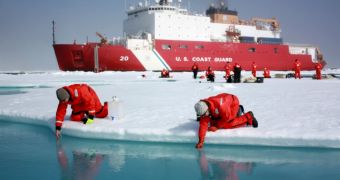Scientists who conducted the Impacts of Climate on EcoSystems and Chemistry of the Arctic Pacific Environment (ICESCAPE) study were puzzled to discover that the waters of the Arctic Ocean are the most phytoplankton-rich in the world.
The team likened this discovery to finding a tropical rain forest in the middle of the Sahara Desert. They say that this phenomenon was made possible by global warming, which is currently raising temperatures in the ocean, and redesigning current patterns.
In order to conduct the study, the team had to pierce through three-foot (1-meter) thick sea ice, and collect water samples from a variety of locations throughout the Arctic. Phytoplankton was targeted because these microscopic marine plants are extremely important for oceanic food webs.
They also play a significant role in the ocean's ability to remove carbon dioxide from the atmosphere. The ICESCAPE expedition was sponsored by NASA, and made use of the US Coast Guard (USCG) Cutter Healy as a science platform.
The oceanographic expedition was conducted in the summer of 2010 and 2011, at various locations in the Beaufort and Chukchi seas. They are located along the western and northern coasts of Alaska.
“Part of NASA's mission is pioneering scientific discovery, and this is like finding the Amazon rainforest in the middle of the Mojave Desert,” explains the program manager for ocean biology and biogeochemistry at NASA Headquarters, Paula Bontempi.
“We embarked on ICESCAPE to validate our satellite ocean-observing data in an area of the Earth that is very difficult to get to. We wound up making a discovery that hopefully will help researchers and resource managers better understand the Arctic,” she adds.
Previously, it was thought that phytoplankton only developed in the Arctic during the times when sea ice melted. The ice usually blocks out sunlight, which is essential for the microorganisms to conduct photosynthesis. What they found was that global warming was changing all that.
Higher temperatures led to the thinning of the ice cover, which in turn allowed more sunlight to penetrate beneath, boosting phytoplankton growth. Details of the process were published in the June 7 issue of the top journal Science.
“At this point we don't know whether these rich phytoplankton blooms have been happening in the Arctic for a long time and we just haven't observed them before. These blooms could become more widespread in the future, however, if the Arctic sea ice cover continues to thin,” Kevin Arrigo says.
“If someone had asked me before the expedition whether we would see under-ice blooms, I would have told them it was impossible. This discovery was a complete surprise,” adds the expert, a professor at the Stanford University and the leader of the ICESCAPE mission. He was also the lead author of the Science paper.

 14 DAY TRIAL //
14 DAY TRIAL //